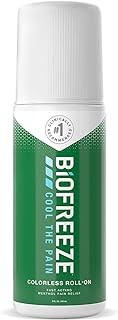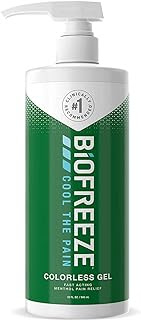Medically reviewed by, Russell Braun RPH
Biofreeze is a topical medication that is widely used to treat aches and pains. Does it seem too good to be true that medicine you apply to the skin actually relieves muscle soreness and joint pain? Also, does Biofreeze really reduce inflammation that is causing that pain?
1. What Is Biofreeze?
Biofreeze is a product that relieves pain by providing a cooling effect. It has been widely used by medical professionals since the 1990’s when it came on the market. The main ingredient is menthol, which is also known as a counterirritant.
Common uses include muscle soreness, aching joints and even arthritis pain. Biofreeze is available over the counter with no prescription required.
2. Does Biofreeze Actually Do Anything?
Many people question if topical over the counter drugs really work as they claim. To get to the bottom of that question we need to understand what the active ingredient menthol actually does.
Counterirritants
Menthol actually irritates the nerves in the area where it is applied. The cooling effect you feel comes from this nerve irritation. At first it may seem warm and then change to cool. The cooling sensation actually prevents pain signals from being transmitted back to the brain. Therefore, providing you with pain relief.
When completely rubbed in the menthol can start to provide pain relief within minutes.
3. Is Biofreeze Anti Inflammatory?
Inflammation is defined as a condition where part of the body becomes reddened, swollen, hot and often painful. The meaning of the word in Latin means “to set on fire”.
When you think of inflammation in this way then it makes sense Biofreeze would be anti inflammatory. The heat of inflammation comes from blood flow being opened up in an area so that more immune cells can come in and kill the offending agent and promote healing. The great thing about biofreeze is it also promotes vasodilation so that the waste from damaged cells can be quickly removed.
The menthol in biofreeze actually works on cold receptors on nerve endings to produce this effect. Most people state they feel this almost feels like the area is numb. As the brain receives fewer signals of pain, it stops sending signals for the immune system to continue with the inflammation process.
Cryotherapy
Cryotherapy is just another word for cold therapy. In most cases when you have an injury that becomes swollen and red you grab some ice to put on it. This ice helps prevent further swelling and inflammation.
The same is true for biofreeze, the cooling sensation has an effect similar to ice. Cold sensations, also known as cryotherapy, do help reduce inflammation.
4. How Should Biofreeze Be Used?
Biofreeze is mainly used for temporary relief from minor aches and pains of sore muscles and joints. Typically uses are associated with conditions such as:
- Arthritis
- Backache
- Strains
- Sprains
There are many different dosage forms of biofreeze. You should look for the product that will make the most sense for the area you will be applying it to. Normally you want to rub, roll or massage the product in until it can no longer been seen on the skin.
When using Biofreeze you will notice that the effects will wear off after a few hours. That is why it can be used up to four times per day.
Stop use and consult a doctor if the condition gets worse. It is also a good idea to seek medical advice if you need to use biofreeze for more than 7 days.
5. Is It Ok To Use Biofreeze Everyday?
It is important to understand that inflammation is a never the root cause of your problem. Rather it is a sign of an underlying health condition. It is always best to try and work with your doctor to understand what that health condition is and go about rebalancing it.
However, you don’t have to suffer until you get the root cause of inflammation under control. Using anti inflammatories like Biofreeze in the short term can help you stay active. In fact, if you have pain on a daily basis you can use Biofreeze every day. Please remember this should be short term (7-10 days) unless you consult your doctor.
6. What Are The Side Effects Of Biofreeze?
Like most topically used pain medications Biofreeze has few side effects. The most notable ones affect the skin area where the medication is being applied. These effects can include:
- Skin irritation
- Dryness
- Redness
- Stinging
Other more rare side effects can also occur. You should ask talk to your doctor if you experience any of the following.
| Dizziness | Rash |
| Itching | Swelling |
| Drowsiness | Trouble breathing |
7. What Is the Best Anti Inflammatory Cream To Use?
Biofreeze is a single ingredient product. Therefore, it only contains menthol and the main difference between Biofreeze products is the percentage of menthol (ranging from 4%-10%). As a result, the higher the percentage the more of an effect it will have on the pain.
All the different forms of Biofreeze are shown in the table below. Another commonly used and effective anti inflammatory cream is Tiger Balm.
| Biofreeze Spray | Menthol 10.5% |  |
| Biofreeze Roll on | Menthol 4% |  |
| Biofreeze Patch | Menthol 5% |  |
| Biofreeze Cream | Menthol 10% |  |
| Biofreeze Gel Pump | Menthol 4% |  |
| Biofreeze Singles | Menthol 4% |  |
Click here to get Dr. Jason Reed’s exclusive list of medication questions you MUST ask your doctor, for FREE!
Share your story
Have you tried Biofreeze? Also, please share how it worked for you. Chime in below with your comments and thoughts.
References:
Sundstrup, Emil et al. Acute effects of topical menthol on chronic pain in slauterhouse workers with carpal tunnel syndrome. Hindawi. 2014: 1-7.